First-Time Horse Trailer Buyer’s Guide: Your Path to a Safe & Smart Purchase
Chelsea started riding when she was seven, joined 4-H as a teen, and rode on her college equestrian team. But when she bought her first horse, a gelding named Sherwin, the stakes got real. She needed a way to get to competitions.
“Buying a trailer is a big deal,” Chelsea said. “It was daunting. I had no idea what to look for.”
 Pictured Above: Chelsea and her horse Sherwin
Pictured Above: Chelsea and her horse Sherwin
She started like most first-time buyers: searching for a used 2-horse bumper pull that fit her budget. With her dad’s help, she found one, but it needed serious work. After spending weeks on repairs to the rusty frame and rotted wood floor, she finally felt safe enough to hit the road.
Years later, with bigger goals and longer hauls ahead, Chelsea upgraded to a 2-horse gooseneck trailer. “I can pull the trailer with two horses and everything I need for a week down and back to South Carolina without a problem.”
Her advice for new buyers? “Don’t rush. Bring a knowledgeable friend. Do your homework.”
If this is your first trailer purchase, don’t skip the safety step, our free step-by-step horse trailer safety checklist makes sure you catch every potential hazard.
Buying Your First Trailer? Here's What Chelsea Wishes She Knew Sooner
If you’re buying your first horse trailer, you're probably asking:
- What type of trailer should I get?
- Can my truck tow it?
- What’s actually safe and what’s just marketing?
- How much does it really cost?
- Can I finance it?
- Should I go new or used?
We’ll walk you through everything, clearly, honestly, and without the dealer pressure.
📌 Key Takeaway: You don’t have to figure this out alone, and you don’t have to settle for an average trailer that’s “good enough.”
What Type of Trailer Is Best for Beginners?
For most first-time buyers, a 2-horse bumper pull trailer is the ideal starting point. It’s easier to handle, more affordable, and compatible with a wider range of tow vehicles. Later, as your needs grow, you might upgrade to a more spacious and stable gooseneck trailer, much like Chelsea did.
| Trailer Type | Pros | Cons |
| Bumper Pull | Easy to hitch, tow, and park. Works with an SUV or half-ton truck. | Limited to 2–3 horses. |
| Gooseneck | More stable. More storage. Great for heavier loads or long hauls. | Requires a pickup with a bed hitch. |
| Living Quarters | Combines horse + human space. Great for overnights. | Heavier and more expensive. Not beginner-friendly unless needed. |
Safety Features You Shouldn’t Compromise On
Here’s what you want to see and why it matters:
✅ Z-Frame or equivalent – A frame built for strength and lightness. It’s stronger than aluminum but lighter than steel, providing a better strength-to-weight ratio.
✅ No wood flooring – Wood floors can rot over time from moisture and manure, creating a serious collapse hazard. A high-quality material like a composite floor eliminates this risk.
✅ Insulated leak-proof roof – Prevents heat buildup in the summer and keeps the interior cooler. It also prevents leaks and damage to the trailer's interior.
✅ Reverse slant load design – Encourages natural loading for horses and provides better balance during transport.
✅ SafeTack® swing-out rear tack – This design eliminates tight corners and center posts, creating a wide, open space that makes loading safer for you and your horse.
✅ Drop-down windows – Improve airflow and ventilation, which is critical for preventing heat stress.
✅ Durable wall panels – Keep your horses safer from sudden stops or kicks, preventing injury and potential escapes.
Did You Know? Studies show that horses who ride facing backward arrive less fatigued and more balanced.
How Much Does a First Trailer Really Cost?
Most first-time buyers focus only on the sticker price, but there are other real-world costs to consider in your first year of ownership.
| Expense | Estimated Cost |
| Base trailer (2-horse bumper pull) | $25,000–$40,000 |
| Safety + comfort upgrades | $2,000–$6,000 |
| Delivery | $395 flat rate (Double D Trailers) |
| Insurance (Year 1) | $400–$800 |
| Maintenance (Year 1) | $250–$500 |
| Registration/taxes | Varies by state |
📈 Estimated Year 1 Cost: $28,000 – $48,000
Explore the full cost breakdown →
Did You Know?
Loading struggles are the #1 reason buyers upgrade. Our SafeTack Reverse trailer makes it easier and safer. Learn more about our unique advantages.
Avoid These First-Time Buyer Mistakes
Overloading your vehicle: Just because your truck can pull a trailer doesn't mean it can stop safely. Always check your truck's Gross Combined Weight Rating (GCWR).
Choosing wood floors: As Chelsea learned, moisture and manure lead to rot, odor, and a collapse risk.
Skipping airflow + insulation: Heat stress is a real danger. A properly ventilated and insulated trailer protects your horse.
Buying off a dealer lot: Most dealer stock is built for margin, not safety. It's often generic and lacks the customization for your specific needs.
Ignoring resale value: A low-quality trailer loses value fast. Investing in quality upfront lowers your lifetime cost.
Pro Tip: Invest in quality materials upfront to lower your lifetime cost and increase resale value.
What Kind of Truck Do You Need?
You should always match your trailer to your tow vehicle, not the other way around. Here’s a quick guide:
| Vehicle Type | Max Towing | Trailer Fit |
| SUV (Tahoe, Expedition) | 5,000–8,000 lbs | 1–2 horse bumper pull |
| Half-ton truck (F-150) | 8,000–12,000 lbs | 2-horse bumper or light gooseneck |
| Heavy-duty truck (F-250) | 12,000–18,000+ lbs | Gooseneck or LQ trailer |
Not sure what your truck can handle? Ask us and we’ll help calculate it for you.
Can You Finance a Horse Trailer?
Yes, and most first-time buyers do. Our financing options are designed to make it simple.
✔️ 10–15% down
✔️ Fixed monthly payments
✔️ Terms from 7 to 15 years
✔️ No early payoff penalties
✔️ Pre-approval without a credit hit
Example: A $35,000 trailer with 10% down (~$3,500) = ~$320–$380/month depending on credit.
First-Time Buyer FAQs
Q: Should I buy new or used? A: While a used trailer can save money up front, it often lacks modern safety features and can hide signs of rust or flooring wear. New trailers offer peace of mind, better customization, a longer lifespan, and higher resale value.
Q: Do I need insulation and ventilation? A: Yes. Trailers without proper airflow or thermal protection can cause overheating, dehydration, and stress, which are serious risks for your horse.
Q: What if my horse is a bad loader? A: Consider a reverse slant trailer with a wide rear entry and full lighting. These design elements can make a significant difference in a horse's willingness to load.
Q: Ramp or step-up? A: Ramps are generally better for green, old, or nervous horses, and they’re safer for you. We recommend them for first-time buyers.
Q: Can I talk to someone before I buy? A: Yes! We offer a free, no-pressure consultation to walk you through your options.
Why Choose Double D Trailers for Your First Trailer?
We’ve worked with thousands of first-time buyers and have built our entire process around what they told us they needed.
- Direct access to Brad Heath and Kalib Norris (owner/lead design specialist).
- Custom-built trailers based on your horse and vehicle.
- Proprietary safety systems like SafeTack®, Z-Frame®, SafeKick®, and SafeBump®.
- Full transparency with progress photos and 3D models.
- 100% Money Back Guarantee if you're not satisfied.
Next Steps for First-Time Buyers
You don’t have to figure this out alone, and you definitely don’t have to buy something off a dealer lot.
Here’s how to start smart:
- 📞 Schedule a Free Video Call With Us →
- 🧰 Try the Trailer Customizer →
- 📘 Join Our Email List to Claim Your FREE Copy of Brad’s Book: “The Honest-to-Goodness Truth About Horse Trailers” →


